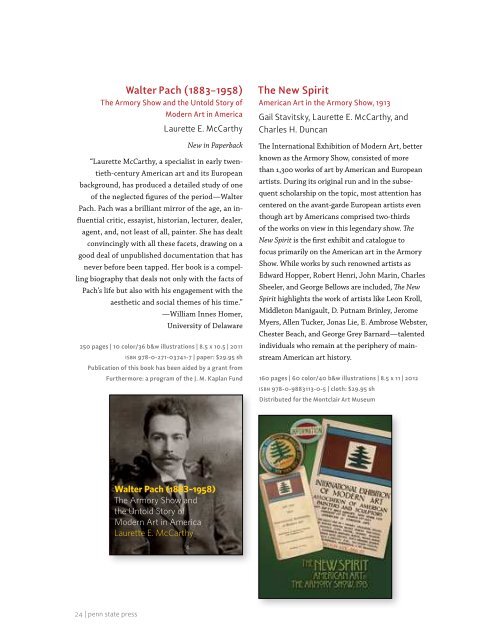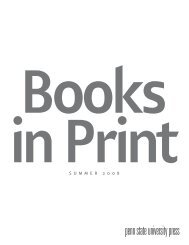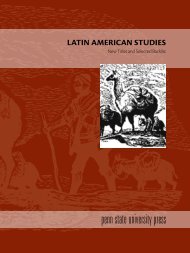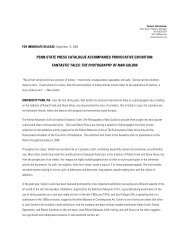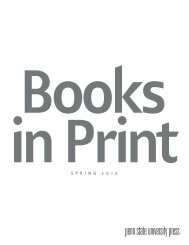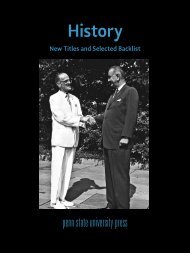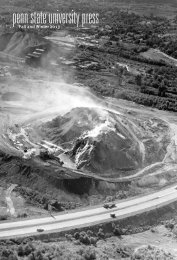Download the Catalog (PDF) - Pennsylvania State University Press
Download the Catalog (PDF) - Pennsylvania State University Press
Download the Catalog (PDF) - Pennsylvania State University Press
You also want an ePaper? Increase the reach of your titles
YUMPU automatically turns print PDFs into web optimized ePapers that Google loves.
PENNSTATEPRESSrn art should miss this thorough and fascinating study of one of <strong>the</strong> most<strong>the</strong> time, still little known except to specialists.”ter College, CUNYof primary sources, Laurette E. McCarthy’s meticulously documentedPach is an important contribution to <strong>the</strong> history of American modernism.”ity of Victoria<strong>the</strong> most gaping lacunae in <strong>the</strong> literature on modern art, for it provides aaccurate portrait of one of <strong>the</strong> most influential yet overlooked figures incan art. Through his writings, lectures, and relentless efforts to educate,ury Walter Pach worked tirelessly behind <strong>the</strong> scenes to introduce modernssentially unaware and uninformed American public. It is safe to say thatnal efforts—particularly as <strong>the</strong>y pertain to <strong>the</strong> organization and staging ofry Show of 1913—<strong>the</strong> development of modern art in America might wellerent course, one far less exciting and intellectually stimulating. Today,rs, and historians—indeed, anyone involved in <strong>the</strong> field of modern andre in one way or ano<strong>the</strong>r indebted to <strong>the</strong> path he charted for us, andcisions that shaped our aes<strong>the</strong>tic future and contributed significantly tod understanding of modern art in America.”, Francis M. Naumann Fine Art, LLCspecialist in early twentieth-century American art and its Europeanduced a detailed study of one of <strong>the</strong> neglected figures of <strong>the</strong> period—as a brilliant mirror of <strong>the</strong> age, an influential critic, essayist, historian,t, and, not least of all, painter. McCarthy has dealt convincingly with allg on a good deal of unpublished documentation that has never beforeok is a compelling biography that deals not only with <strong>the</strong> facts of Pach’sengagement with <strong>the</strong> aes<strong>the</strong>tic and social <strong>the</strong>mes of his time.”, <strong>University</strong> of DelawareThe <strong>Pennsylvania</strong> <strong>State</strong> <strong>University</strong> <strong>Press</strong><strong>University</strong> Park, <strong>Pennsylvania</strong>www.psupress.orgCover illustration: Walter Pach. Photograph byGot<strong>the</strong>lf Pach. Private collection.Jacket design: Jason HarveyWalter Pach (1883–1958)The Armory Show and <strong>the</strong> Untold Story ofModern Art in AmericaLaurette E. McCarthyMcCarthyWalter Pach (1883–1958)The Armory Show and <strong>the</strong> Untold Storyof Modern Art in AmericaNew in Paperback“Laurette McCarthy, a specialist in early twentieth-centuryAmerican art and its Europeanbackground, has produced a detailed study of oneof <strong>the</strong> neglected figures of <strong>the</strong> period—WalterPach. Pach was a brilliant mirror of <strong>the</strong> age, an influentialcritic, essayist, historian, lecturer, dealer,agent, and, not least of all, painter. She has dealtconvincingly with all <strong>the</strong>se facets, drawing on agood deal of unpublished documentation that hasnever before been tapped. Her book is a compellingbiography that deals not only with <strong>the</strong> facts ofPach’s life but also with his engagement with <strong>the</strong>aes<strong>the</strong>tic and social <strong>the</strong>mes of his time.”—William Innes Homer,<strong>University</strong> of Delaware250 pages | 10 color/36 b&w illustrations | 8.5 x 10.5 | 2011isbn 978-0-271-03741-7 | paper: $29.95 shPublication of this book has been aided by a grant fromFur<strong>the</strong>rmore: a program of <strong>the</strong> J. M. Kaplan FundWalter Pach (1883–1958)The Armory Show and<strong>the</strong> Untold Story ofModern Art in AmericaLaurette E. McCarthyThe New SpiritAmerican Art in <strong>the</strong> Armory Show, 1913Gail Stavitsky, Laurette E. McCarthy, andCharles H. DuncanTanya Sheehan is Assistant Professor of ArtHistory at Rutgers, The <strong>State</strong> <strong>University</strong> ofNew Jersey.Jacket illustration: Rhoads' New Photograph Gallery,Portrait of an Unidentified Boy, ca. 1860s. The LibraryCompany of Philadelphia.sheehan_doctored_mechanical_r1.indd 1“This remarkable book combinesclose readings of periodicals with<strong>the</strong>oretical acumen and interpretiveinsights, revealing <strong>the</strong> central rolethat medical metaphors played inAmerican photographic culture in <strong>the</strong>nineteenth century. Convenientlyembodying <strong>the</strong> desires and anxietiesof both photographers and <strong>the</strong>irclients, <strong>the</strong>se medical metaphorswere made manifest as much inadvertisements, cartoons, and articlesas in actual photographic portraits.Casting doubt on any hard-and-fastdistinction between <strong>the</strong> social and <strong>the</strong>physical body, Doctored will change<strong>the</strong> way you think about this period ofAmerican history.”Geoffrey Batchen, Victoria <strong>University</strong>The International Exhibition of Modern Art, betterknown as <strong>the</strong> Armory Show, consisted of morethan 1,300 works of art by American and Europeanartists. During its original run and in <strong>the</strong> subsequentscholarship on <strong>the</strong> topic, most attention hascentered on <strong>the</strong> avant-garde European artists eventhough art by Americans comprised two-thirds“In Doctored, Tanya Sheehaninvestigates <strong>the</strong> discursiveof <strong>the</strong> works on view in this legendary show. Theintersections between photographymedicine in <strong>the</strong> late nineteenthNew Spirit is <strong>the</strong> first exhibit and century. catalogue Sheehan explores to anunderstudied trove of professionalfocus primarily on <strong>the</strong> Americanphotographicart inliterature<strong>the</strong> Armoryin orderto understand <strong>the</strong> history ofphotography from its most popularShow. While works by such renowned artists aspractitioners’ point of view. This isa wonderful visual culture history.”Edward Hopper, Robert Henri, John Shawn Michelle Marin, Smith, School Charlesof <strong>the</strong>Art Institute of ChicagoSheeler, and George Bellows are included, The NewThe <strong>Pennsylvania</strong> <strong>State</strong> <strong>University</strong> <strong>Press</strong>Spirit highlights <strong>the</strong> work of artists like Leon Kroll,<strong>University</strong> Park, <strong>Pennsylvania</strong>www.psupress.orgMiddleton Manigault, D. Putnam Brinley, JeromeCover design: Martyn SchmollMyers, Allen Tucker, Jonas Lie, E. Ambrose Webster,Chester Beach, and George Grey Barnard—talentedindividuals who remain at <strong>the</strong> periphery of mainstreamAmerican art history.160 pages | 60 color/40 b&w illustrations | 8.5 x 11 | 2012isbn 978-0-9883113-0-5 | cloth: $29.95 shDistributed for <strong>the</strong> Montclair Art MuseumNew Spirit Covers_New Spirit 9/25/12 12:06 AM Page 3With <strong>the</strong> centennial of <strong>the</strong> famed 1913Armory Show in New York City approaching,now is <strong>the</strong> ideal time to examine fully, andfor <strong>the</strong> first time, <strong>the</strong> life and work of WalterPach, one of <strong>the</strong> prime movers behind thisseminal event in <strong>the</strong> American art world.Pach was among <strong>the</strong> most influential figuresin <strong>the</strong> history of twentieth-century art andculture, yet surprisingly little has beenwritten about him—and much that has beenwritten offers incorrect information. Pachwas one of <strong>the</strong> earliest and most outspokenpromoters of modern art and was HenriMatisse’s first agent in <strong>the</strong> United <strong>State</strong>s.Through his multiple roles as critic, agent,liaison, and lecturer, Pach promoted modernEuropean, American, and Mexican artand helped win its acceptance throughout<strong>the</strong> North American continent. LauretteMcCarthy’s detailed account reintroduces usto this key figure in <strong>the</strong> world of modern art.“Tanya Sheehan’s Doctored is culturalhistory at its best, combininga magisterial examination ofnineteenth-century photographicliterature with a persuasive andnuanced argument about metaphorand photography’s discursive claimsto professional expertise. A mustreadfor scholars of photography,art history, American studies,nineteenth-century cultural history,and urban studies.”Elspeth H. Brown, <strong>University</strong>of Toronto“Doctored is a highly original andthoughtful study that illuminates <strong>the</strong>rich ties between nineteenth-centuryAmerican portrait photography andmedical practice. It illustrates how<strong>the</strong> nascent medium of photographygained legitimacy by forging tiesto science and explores <strong>the</strong> deeplyrooted belief in photography as acure for social and even physicalills. The book makes a majorcontribution to our understandingof early photographic practice andits complex relationship to medicine,race, and class.”Martin A. Berger, <strong>University</strong> ofCalifornia, Santa CruzISBN 978-0-271-03792-9SheehanDOCTOREDThe Medicine of Photography inNineteenth-Century AmericaPENNSTATEPRESSDOCTOREDThe Medicine of Photography inNineteenth-Century America“Anatomyshould bestudiedby <strong>the</strong>poser.”— W. H. TiptonTanyaSheehanDoctoredThe In Doctored, Medicine Tanya Sheehan of takes Photography a new look inat <strong>the</strong> relationship between photographyNineteenth-Century Americaand medicine in American culture from <strong>the</strong>Tanya Sheehannineteenth century to <strong>the</strong> present. Sheehanfocuses on Civil War and postbellumPhiladelphia, exploring <strong>the</strong> ways in whichNew in Paperbackmedical models and metaphors helpedstreng<strong>the</strong>n <strong>the</strong> professional legitimacy of <strong>the</strong>city’s commercial photographic community“Sheehan’sat a time when it wasDoctorednot well established.adds an important confluence ofBy reading <strong>the</strong> trade literature and materialscience and art to published histories of photography.. . . The interdisciplinary nature of [Sheehan’s]practices of portrait photography and medicinein relation to one ano<strong>the</strong>r, she shows how <strong>the</strong>irinteraction defined <strong>the</strong> space of <strong>the</strong> urbanproject portrait studio makes as well as <strong>the</strong> it physical suitable and social not only for photo historians,methods of but social art also history, for science those studies, interested in medical andeffects of studio operations. Integrating <strong>the</strong>and media studies, Doctored reveals importantscientific history, critical race studies, and culturalconnections between <strong>the</strong> professionalization ofstudies.”American photographers and <strong>the</strong> constructionof photography’s cultural identity.1/17/11 1:34:59 PM—Emily Una Weirich,Art Libraries Society of North America Reviews“Doctored is a highly original and thoughtful studythat illuminates <strong>the</strong> rich ties between nineteenthcenturyAmerican portrait photography and medicalpractice. It illustrates how <strong>the</strong> nascent medium ofphotography gained legitimacy by forging ties toscience and explores <strong>the</strong> deeply rooted belief inphotography as a cure for social and even physicalills. The book makes a major contribution to ourunderstanding of early photographic practice and itscomplex relationship to medicine, race, and class.”—Martin A. Berger,<strong>University</strong> of California Santa Cruz216 pages | 44 illustrations | 7 x 10 | 2011isbn 978-0-271-03792-9 | cloth: $74.95 shisbn 978-0-271-03793-6 | paper: $39.95 sh24 | penn state press www.psupress.org | 25


